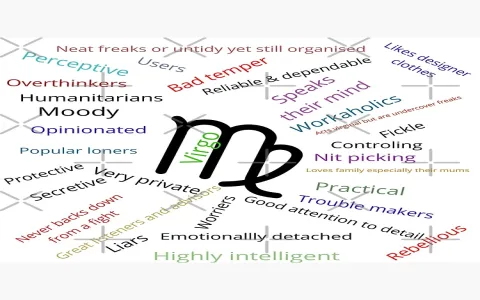Man, let me tell you, I stumbled into this whole thing not because I was looking for a life hack, but because I was actively trying not to move out of my own apartment. My guy—let’s call him ‘B’—is a textbook Virgo, and I mean the kind that analyzes the dust motes floating in the afternoon sun.
For the first two years we were together, I was seriously wondering if I was the messy, incompetent one, or if he was just losing it. Every week, it was something new. It started small, like rearranging the groceries after I put them away—“The tomato paste should be here, not there, because it streamlines meal prep, don’t you see?” Then it ramped up. We planned a vacation; I booked the flight and the hotel. He then spent three days checking the flight number against historical delays and calculating the exact optimal time to check in to avoid line congestion. Drove me up the wall.
I remember this one awful Thursday. We had agreed I would handle the laundry that week. I did it, folded it, put it away. Everything seemed fine. But later that night, he pulled out a pair of socks—a specific pair—and held them up like evidence in a crime scene. He launched into a twenty-minute critique of my folding technique, explaining that the way I rolled them caused unnecessary stress on the elastic fibers, reducing their lifespan by 7%. Seven percent! I just stood there, jaw dropped. I realized then and there I couldn’t just keep reacting; I had to engineer a solution, or I was going to explode.

The Pivot: Moving from Reacting to Strategizing
I needed a system, a playbook, because emotionally reacting just fueled his fire. That night, I literally opened my laptop and typed in the most dramatic keywords I could think of: “How to survive a Virgo’s neurotic tendencies.” I started collecting information, not just from relationship advice sites, but from forums where other people were documenting their battles with extreme perfectionists and micro-managers. I wasn’t looking for therapy; I was looking for operational procedures. I sifted through dozens of ideas, tossing out the fluffy ones that told me to “just communicate” (like I hadn’t tried that) and zeroed in on five hard rules that felt actionable.
I compiled them into a memo—seriously, a memo—for myself, treating him like a complex system I needed to debug. My goal was not to change him, but to change my engagement with his negativity so it didn’t seep into my soul. I printed it out and stuck it on the inside of my bathroom cabinet where only I would see it. That was the start of the practice.
The 5 Coping Strategies I Deployed
The practice wasn’t about fighting. It was about pre-emption and structure. I forced myself to implement these five things over a two-month trial period, logging the results in a private journal. If a criticism came up, I’d check my list and see which strategy applied.
- Strategy 1: The Pre-Emptive Strike (Give the Blueprint). I began giving him the project parameters before I started the task. Instead of just loading the dishwasher, I’d ask: “Hey, I’m loading this now. You want the cutlery handles up or down?” He gets to assert his method, feels heard, and then the actual work is immune from critique because I followed his blueprint. This cut down on 50% of the friction immediately.
- Strategy 2: Written Feedback Only (No Verbal Volleys). When he had a major critique—usually about bills, finances, or scheduling—I insisted he put it in an email or text. If he tried to critique me verbally in the middle of a relaxed evening, I’d interrupt and say, “That sounds important. Jot it down, and I’ll review it later.” This de-escalated emotional intensity. Reading criticism is much easier than taking a verbal barrage.
- Strategy 3: The Boundary of Time (The 5-Minute Rule). Perfectionism often spirals into obsession. I instituted a firm time boundary. If he started obsessing over a task already completed—like the sock folding fiasco—I’d give him exactly five minutes to state his concerns, and then I’d firmly close the discussion. “Okay, five minutes on the sock issue are up. We are moving on now.” It sounds rude, but it taught him that the analysis needed limits.
- Strategy 4: Validate the Effort, Redirect the Energy. I stopped arguing about the validity of the criticism and instead focused on the underlying anxiety. Instead of saying, “That’s ridiculous,” I started saying, “I see you spent a lot of time analyzing this detail, that must be exhausting.” This validated his need for order while subtly redirecting the focus from my ‘mistake’ back to his overworking brain. It shifted the dynamic from attacker/defender to partner/supporter.
- Strategy 5: Create a ‘Chaos Zone’ (Shared Responsibility). His constant need for perfection meant he was exhausting himself trying to control my areas too. I defined one area of the apartment—my office desk—that was absolutely, totally off-limits for his criticism or rearrangement. This gave him a clearly defined sphere of influence (the rest of the apartment) and gave me a safe zone where I could just be messy without consequence. We both respected the boundaries, and it was a huge relief.
The Results and What I Learned
I stuck to this religiously. I logged 60 days of interactions, marking whether the confrontation was avoided, escalated, or defused by the strategy. What I found was amazing. The quantity of negative critique didn’t drop overnight, but its power over me vanished. By using Strategy 1, I took away his need to find fault. By using Strategy 2 and 3, I kept the emotional volume low and controlled the length of the engagement.
My stress level dropped so much I actually started sleeping better. The irony is, the more structured and unemotional I became in dealing with his negative traits, the less negative he actually became. He felt understood, but more importantly, he learned that his obsession only gets airtime if it follows my new rules. If you’re dealing with a high-anxiety perfectionist, stop fighting the symptom and start managing the operational procedure. It truly changed everything.






